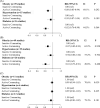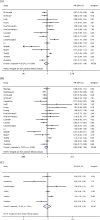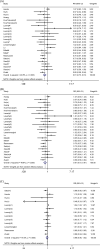Active commuting and the risk of obesity, hypertension and diabetes: a systematic review and meta-analysis of observational studies
- PMID: 34172487
- PMCID: PMC8237743
- DOI: 10.1136/bmjgh-2021-005838
Active commuting and the risk of obesity, hypertension and diabetes: a systematic review and meta-analysis of observational studies
Abstract
Active commuting may hold a potential for preventing adverse health outcomes. However, evidence of the association of active commuting and the risk of health outcomes remains debatable. The current study systematically and quantitatively summarised research findings on the association between active commuting and the risk of the mentioned health outcomes. We comprehensively searched four databases (PubMed, EMBASE, Web of Science and Open Grey) from inception to 2 August 2020 for observational studies investigating the associations among adult population. Summary relative risks (RRs) and 95% CIs were estimated for the association. Heterogeneity was investigated using Cochran's Q test and the I 2 statistic. Restricted cubic splines were used to evaluate linear and nonlinear relations. The search yielded 7581 initial references. We included 28 articles in the meta-analysis. Compared with inactive commuting, active commuting reduced the risk of obesity (RR=0.88, 95% CI 0.83 to 0.94, I2=69.1%), hypertension (RR=0.95, 95% CI 0.87 to 1.04, I2=82.2%) and diabetes (RR=0.82, 95% CI 0.76 to 0.90, I2=44.5%). Restricted cubic splines showed linear associations between active commuting and obesity, hypertension and diabetes (Pnonlinearity=0.640; Pnonlinearity=0.886; Pnonlinearity=0.099). As compared with the lowest active commuting group, the risk of obesity, hypertension and diabetes in the highest active commuting group were reduced by 13% (95% CI 0.82 to 0.93, I2=65.2%); 6% (95% CI 0.86 to 1.02, I2=75.2%) and 19% (95% CI 0.73 to 0.91, I2=49.8%) respectively. Active commuting seemed to be associated with lower risk of obesity, hypertension and diabetes. However, the results should be interpreted cautiously because this meta-analysis was based solely on observational studies.PROSPERO registration numberCRD42020202723.
Keywords: diabetes; epidemiology; public health.
© Author(s) (or their employer(s)) 2021. Re-use permitted under CC BY-NC. No commercial re-use. See rights and permissions. Published by BMJ.
Conflict of interest statement
Competing interests: None declared.
Figures





Similar articles
-
Sugar and artificially sweetened beverages and risk of obesity, type 2 diabetes mellitus, hypertension, and all-cause mortality: a dose-response meta-analysis of prospective cohort studies.Eur J Epidemiol. 2020 Jul;35(7):655-671. doi: 10.1007/s10654-020-00655-y. Epub 2020 Jun 11. Eur J Epidemiol. 2020. PMID: 32529512
-
Potato Intake and the Risk of Overweight/Obesity, Hypertension, Diabetes, and Cardiovascular Disease: A Systematic Review and Meta-analysis of Observational Studies.Nutr Rev. 2025 Mar 1;83(3):466-478. doi: 10.1093/nutrit/nuae159. Nutr Rev. 2025. PMID: 39527022
-
Active Commuting and Multiple Health Outcomes: A Systematic Review and Meta-Analysis.Sports Med. 2019 Mar;49(3):437-452. doi: 10.1007/s40279-018-1023-0. Sports Med. 2019. PMID: 30446905
-
The association between physical activity with incident obesity, coronary heart disease, diabetes and hypertension in adults: a systematic review of longitudinal studies published after 2012.BMC Public Health. 2020 May 19;20(1):726. doi: 10.1186/s12889-020-08715-4. BMC Public Health. 2020. PMID: 32429951 Free PMC article.
-
Fried-food consumption and risk of overweight/obesity, type 2 diabetes mellitus, and hypertension in adults: a meta-analysis of observational studies.Crit Rev Food Sci Nutr. 2022;62(24):6809-6820. doi: 10.1080/10408398.2021.1906626. Epub 2021 Apr 7. Crit Rev Food Sci Nutr. 2022. PMID: 33825582
Cited by
-
Area-level associations of travel behaviour metrics with waist circumference: findings from linkage of travel and health surveys.Sci Rep. 2023 May 19;13(1):8136. doi: 10.1038/s41598-023-35335-w. Sci Rep. 2023. PMID: 37208412 Free PMC article.
-
The 'climate emergency', and how we respond.Future Healthc J. 2025 Mar 31;12(1):100228. doi: 10.1016/j.fhj.2025.100228. eCollection 2025 Mar. Future Healthc J. 2025. PMID: 40236930 Free PMC article.
-
Impact of changes in commuting mode on body weight among Japanese workers: a longitudinal study.J Occup Health. 2024 Jan 4;66(1):uiae027. doi: 10.1093/joccuh/uiae027. J Occup Health. 2024. PMID: 38782720 Free PMC article.
-
Active transportation is associated with lower obesity risk: generalized structural equations model applied to physical activity.Cad Saude Publica. 2025 Jan 13;40(12):e00035624. doi: 10.1590/0102-311XEN035624. eCollection 2025. Cad Saude Publica. 2025. PMID: 39813567 Free PMC article.
-
Associations of active commuting and leisure-time physical activity with perceived cognitive function and work ability among Finnish employed adults: a population-based study.BMC Public Health. 2025 Apr 16;25(1):1423. doi: 10.1186/s12889-025-22634-2. BMC Public Health. 2025. PMID: 40241029 Free PMC article.
References
-
- GBD 2017 Causes of Death Collaborators . Global, regional, and national age-sex-specific mortality for 282 causes of death in 195 countries and territories, 1980-2017: a systematic analysis for the global burden of disease study 2017. Lancet 2018;392:1736–88. 10.1016/S0140-6736(18)32203-7 - DOI - PMC - PubMed
Publication types
MeSH terms
LinkOut - more resources
Full Text Sources
Medical
Research Materials
